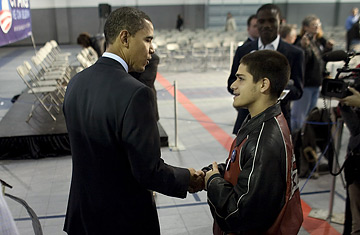
Democratic presidential hopeful Sen. Barack Obama greets a young supporter in Monticello, Iowa.
Last summer, Barack Obama took a lot of heat for skipping a candidate forum in Iowa sponsored by the AARP, choosing instead to attend a hip-hop event starring Usher.
But Obama clearly knew something others didn't, and that zig where others zagged now appears to have been a shrewd move on the path to a dramatic achievement. Obama's youth-oriented campaign drew under-25 voters to Thursday's Iowa caucuses in record numbers, and these first-time voters gave him most of his margin of victory.
Turnout among the youngest slice of the electorate more than doubled from 2004, when Howard Dean's intense campaign on college campuses produced far more modest results. This was part of an overall surge in Democratic participation — but while overall Democratic turnout jumped 90%, the number of young Democrats participating soared 135%.
According to surveys of voters entering the caucuses, young voters preferred Obama over the next-closest competitor by more than 4 to 1. This suggests that the under-25 set — typically among the most elusive voters in all of politics — gave the Illinois Senator a net gain of some 17,000 votes; Obama finished roughly 20,000 votes ahead of former Senator John Edwards and Sen. Hillary Clinton.
"Conventional wisdom" — reflected in an article by this reporter earlier this week — "has a name for candidates who rely on the youth vote: loser," said Michael McDonald, an expert on voter turnout at George Mason University. "Clearly, this was different."
Because of the arcane rules of the Democratic caucuses, this success was self-reinforcing. All candidates were required to draw at least 15% of the vote in a given precinct; if they failed, their supporters had to line up behind their second choice. The unprecedented large turnout put the 15% mark out of reach of candidates like Sen. Joseph Biden and Sen. Christopher Dodd, and many of their backers turned to Obama.
A close reading of the numbers suggests that the youth vote was widely dispersed across the state and not concentrated in college towns, as some might have assumed. Turnout in Johnson County (home of the University of Iowa) and Story County (home of Iowa State University) was up compared to 2004, but less dramatically than in many other counties. Iowa-bred students were apparently voting at home, and the specter feared by some pundits, of an army of out-of-state students jamming campus precincts, seems to have evaporated.
The youth appeal of Barack Obama was evident in the big crowds he drew as he campaigned across Iowa. There were a lot of fresh faces in those audiences, and many of them left wearing one of his extremely cool t-shirts.
But according to McDonald, rallies, concerts and merchandise weren't the reason for the campaign's success. Obama applied lessons learned — re-learned — in recent years about the importance of face-to-face grassroots organizing.
After decades of relying on phone banks and mass-mailings to motivate voters, "the Republicans began experimenting in 2001, comparing face-to-face contacts to the other methods. They found that having a trusted neighbor or peer make the personal appeal is a far more effective way to get voters to the polls," McDonald said. "Obama has keyed into that and built his campus organizations. It's really a return to the way we used to organize in the 19th century heyday of political machines."
Moreover, Obama's appeal to young voters fits seamlessly into his larger campaign themes of change and renewal. His support radiated upward to voters in their 30s and early 40s, the entrance polls indicated.
"So he is not relying entirely on the youth vote," said McDonald, who believes this will be important to Obama's fortunes next Tuesday in the New Hampshire primary. There, he points out, the mid-range of the electorate, voters 30 to 60, have traditionally formed a larger slice of the turnout than in Iowa.
"Hillary Clinton" he said, "may be the one in danger of having all her eggs in one basket. She was strongest with elderly voters in Iowa, but they also play a smaller part in New Hampshire."
